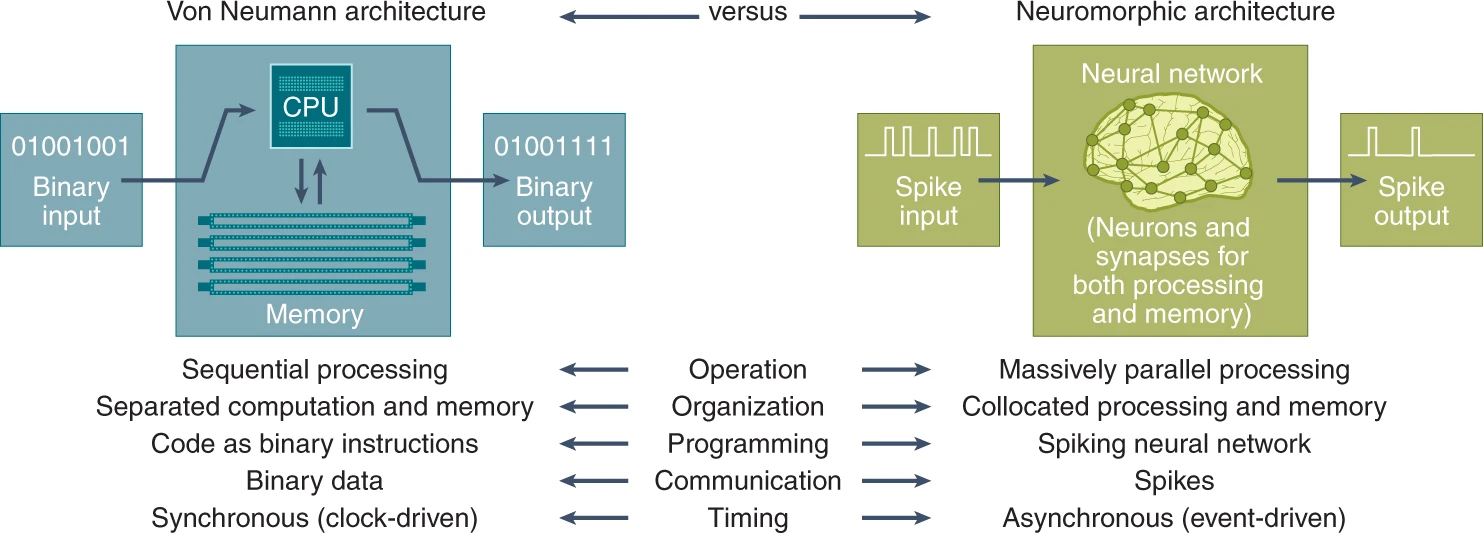- Home
- Prelims
- Mains
- Current Affairs
- Study Materials
- Test Series
 EDITORIALS & ARTICLES
EDITORIALS & ARTICLES
Neuromorphic Computing
- Neuromorphic computing is a process designed to mimic the structure and function of the human brain using artificial neurons and synapses.
- It represents a significant shift from traditional binary computing to neuromorphic computing, allowing systems to learn from the environment.
- Working Mechanism:
- It involves the use of Artificial Neural Networks (ANN) made up of millions of artificial neurons, similar to those in the human brain.
- These neurons pass signals to each other in layers, converting input into output through electric spikes or signals, based on the architecture of Spiking Neural Networks (SNN).
- This allows the machine to mimic the neuro-biological networks in the human brain and perform tasks efficiently and effectively, such as visual recognition and data interpretation.
- Key Features:
- Brain-Inspired Design: Neuromorphic systems replicate the brain''s architecture, particularly the neocortex, which is responsible for higher cognitive functions such as sensory perception and motor commands.
- Spiking Neural Networks: These systems use spiking neurons that communicate through electrical signals, closely resembling biological neuronal behavior. This design allows for parallel processing and real-time learning.
- Integration of Memory and Processing: Unlike traditional von Neumann architecture, which separates memory from processing, neuromorphic systems integrate these functions, enhancing computational efficiency.
- Advantages:
- It allows computers to process information more efficiently, enabling faster problem-solving, pattern recognition, and decision-making compared to traditional computing systems.
- It has the ability to revolutionise AI hardware, enabling complex tasks like training Large Language Models (LLMs) on personal devices, addressing hardware limitations and energy inefficiencies.
- Current AI tools are restricted to resource-heavy data centers due to a lack of energy-efficient hardware.
- Integration with Molecular Film:
- Molecular films are ultrathin layers of molecules that can be engineered to exhibit specific electrical and optical properties, enabling the creation of brain-inspired data storage and processing devices.
- This film acts as a neuromorphic accelerator, simulating brain-like parallel processing to quickly handle complex tasks like matrix multiplication and improve computer performance when combined with silicon chips.
- The recent advancement involves a molecular film offering 16,500 possible states, surpassing traditional binary systems.
- This film utilizes molecular and ionic movements to represent memory states, mapped via precise electrical pulses, creating a "molecular diary" of states.
| A neuromorphic chip imitates the brain through elements that implement “neurons”, nodes that process information, and “axons”, connections with weights between the nodes that transfer electrical signals using analog circuitry. |
- Differences from Traditional Computing:

- Parallel Processing: Neuromorphic computers can process multiple streams of information simultaneously, unlike traditional computers that operate sequentially.
- Energy Efficiency: They consume less power by computing only when relevant events occur, making them ideal for applications requiring real-time data processing.
- Traditional binary computing operates with bits in two states: 0 or 1, similar to a light switch being on or off. In contrast, analog computing uses continuous values, similar to a dimmer switch with a range of brightness levels.









 Latest News
Latest News General Studies
General Studies